Financial Accounting Report: AGL Energy Expense Analysis
VerifiedAdded on 2020/05/16
|11
|1809
|191
Report
AI Summary
This report presents a financial accounting analysis, examining expense classification methods, accounting policies, and specific items from AGL Energy's financial statements. Task 1 delves into the classification of expenses by nature, comparing it to classification by function, and identifies the method used by AGL Energy. Task 2 focuses on accounting policies, particularly AASB 108, and highlights areas where AGL Energy's annual report might not fully comply. Task 3 examines the notes to the financial statements, including the cost of plant, equipment, and property, depreciation amounts and methods, depreciation periods, and impairment considerations. The report references relevant accounting standards and academic sources to support its analysis and findings, offering a detailed overview of AGL Energy's financial reporting practices. The report showcases the application of accounting principles to real-world financial data.
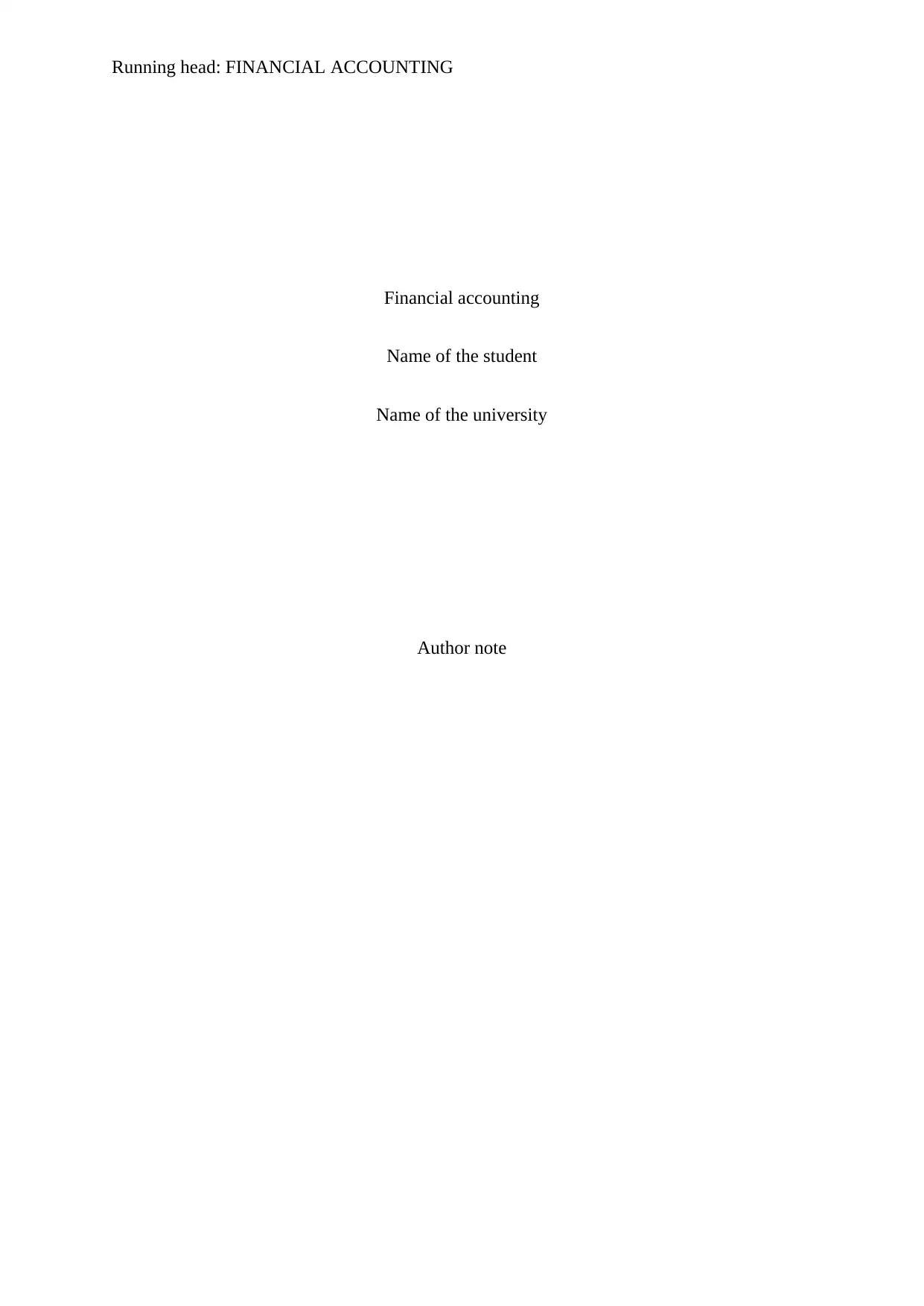
Running head: FINANCIAL ACCOUNTING
Financial accounting
Name of the student
Name of the university
Author note
Financial accounting
Name of the student
Name of the university
Author note
Paraphrase This Document
Need a fresh take? Get an instant paraphrase of this document with our AI Paraphraser
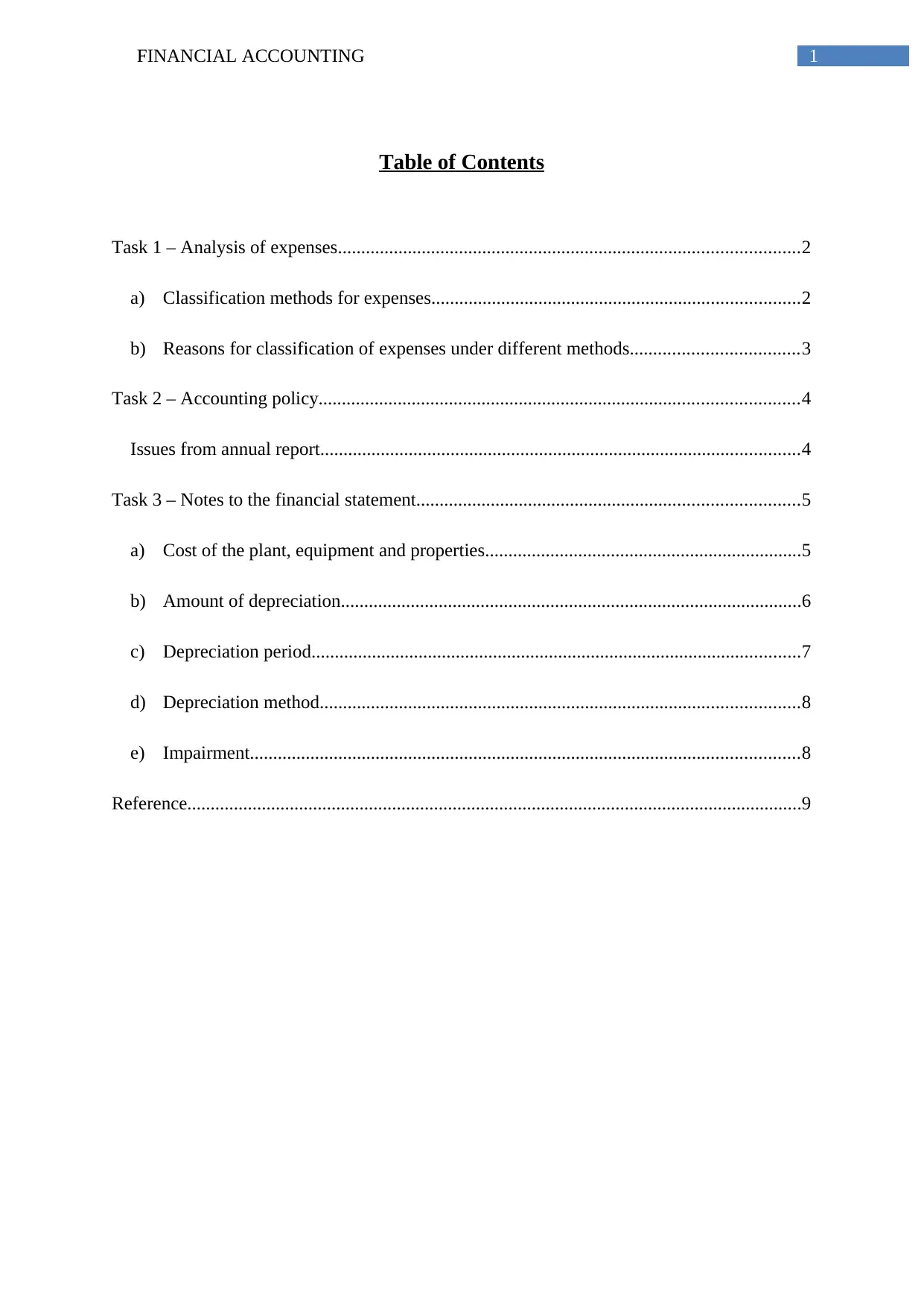
1FINANCIAL ACCOUNTING
Table of Contents
Task 1 – Analysis of expenses...................................................................................................2
a) Classification methods for expenses...............................................................................2
b) Reasons for classification of expenses under different methods....................................3
Task 2 – Accounting policy.......................................................................................................4
Issues from annual report.......................................................................................................4
Task 3 – Notes to the financial statement..................................................................................5
a) Cost of the plant, equipment and properties....................................................................5
b) Amount of depreciation...................................................................................................6
c) Depreciation period.........................................................................................................7
d) Depreciation method.......................................................................................................8
e) Impairment......................................................................................................................8
Reference....................................................................................................................................9
Table of Contents
Task 1 – Analysis of expenses...................................................................................................2
a) Classification methods for expenses...............................................................................2
b) Reasons for classification of expenses under different methods....................................3
Task 2 – Accounting policy.......................................................................................................4
Issues from annual report.......................................................................................................4
Task 3 – Notes to the financial statement..................................................................................5
a) Cost of the plant, equipment and properties....................................................................5
b) Amount of depreciation...................................................................................................6
c) Depreciation period.........................................................................................................7
d) Depreciation method.......................................................................................................8
e) Impairment......................................................................................................................8
Reference....................................................................................................................................9
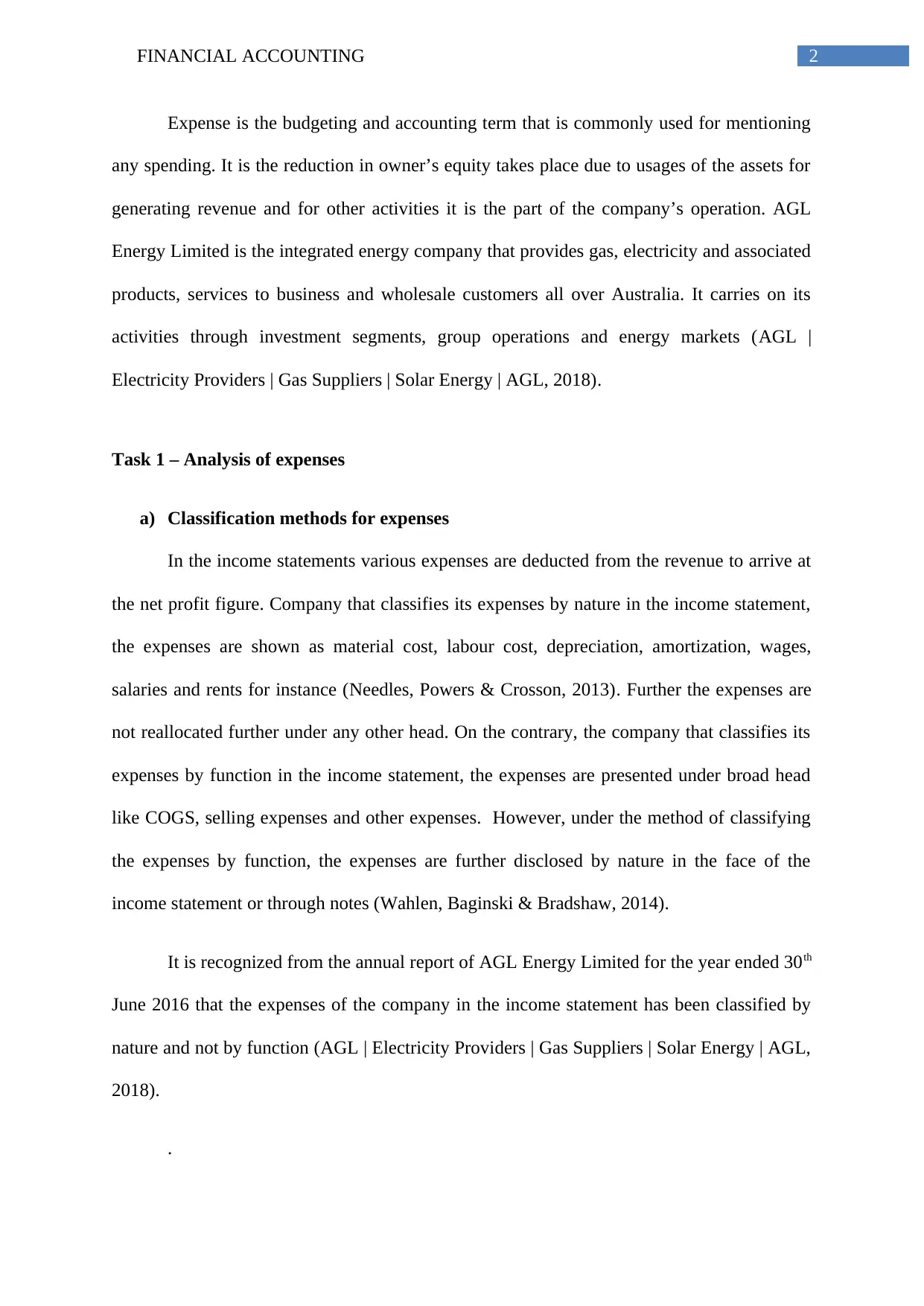
2FINANCIAL ACCOUNTING
Expense is the budgeting and accounting term that is commonly used for mentioning
any spending. It is the reduction in owner’s equity takes place due to usages of the assets for
generating revenue and for other activities it is the part of the company’s operation. AGL
Energy Limited is the integrated energy company that provides gas, electricity and associated
products, services to business and wholesale customers all over Australia. It carries on its
activities through investment segments, group operations and energy markets (AGL |
Electricity Providers | Gas Suppliers | Solar Energy | AGL, 2018).
Task 1 – Analysis of expenses
a) Classification methods for expenses
In the income statements various expenses are deducted from the revenue to arrive at
the net profit figure. Company that classifies its expenses by nature in the income statement,
the expenses are shown as material cost, labour cost, depreciation, amortization, wages,
salaries and rents for instance (Needles, Powers & Crosson, 2013). Further the expenses are
not reallocated further under any other head. On the contrary, the company that classifies its
expenses by function in the income statement, the expenses are presented under broad head
like COGS, selling expenses and other expenses. However, under the method of classifying
the expenses by function, the expenses are further disclosed by nature in the face of the
income statement or through notes (Wahlen, Baginski & Bradshaw, 2014).
It is recognized from the annual report of AGL Energy Limited for the year ended 30th
June 2016 that the expenses of the company in the income statement has been classified by
nature and not by function (AGL | Electricity Providers | Gas Suppliers | Solar Energy | AGL,
2018).
.
Expense is the budgeting and accounting term that is commonly used for mentioning
any spending. It is the reduction in owner’s equity takes place due to usages of the assets for
generating revenue and for other activities it is the part of the company’s operation. AGL
Energy Limited is the integrated energy company that provides gas, electricity and associated
products, services to business and wholesale customers all over Australia. It carries on its
activities through investment segments, group operations and energy markets (AGL |
Electricity Providers | Gas Suppliers | Solar Energy | AGL, 2018).
Task 1 – Analysis of expenses
a) Classification methods for expenses
In the income statements various expenses are deducted from the revenue to arrive at
the net profit figure. Company that classifies its expenses by nature in the income statement,
the expenses are shown as material cost, labour cost, depreciation, amortization, wages,
salaries and rents for instance (Needles, Powers & Crosson, 2013). Further the expenses are
not reallocated further under any other head. On the contrary, the company that classifies its
expenses by function in the income statement, the expenses are presented under broad head
like COGS, selling expenses and other expenses. However, under the method of classifying
the expenses by function, the expenses are further disclosed by nature in the face of the
income statement or through notes (Wahlen, Baginski & Bradshaw, 2014).
It is recognized from the annual report of AGL Energy Limited for the year ended 30th
June 2016 that the expenses of the company in the income statement has been classified by
nature and not by function (AGL | Electricity Providers | Gas Suppliers | Solar Energy | AGL,
2018).
.
⊘ This is a preview!⊘
Do you want full access?
Subscribe today to unlock all pages.

Trusted by 1+ million students worldwide
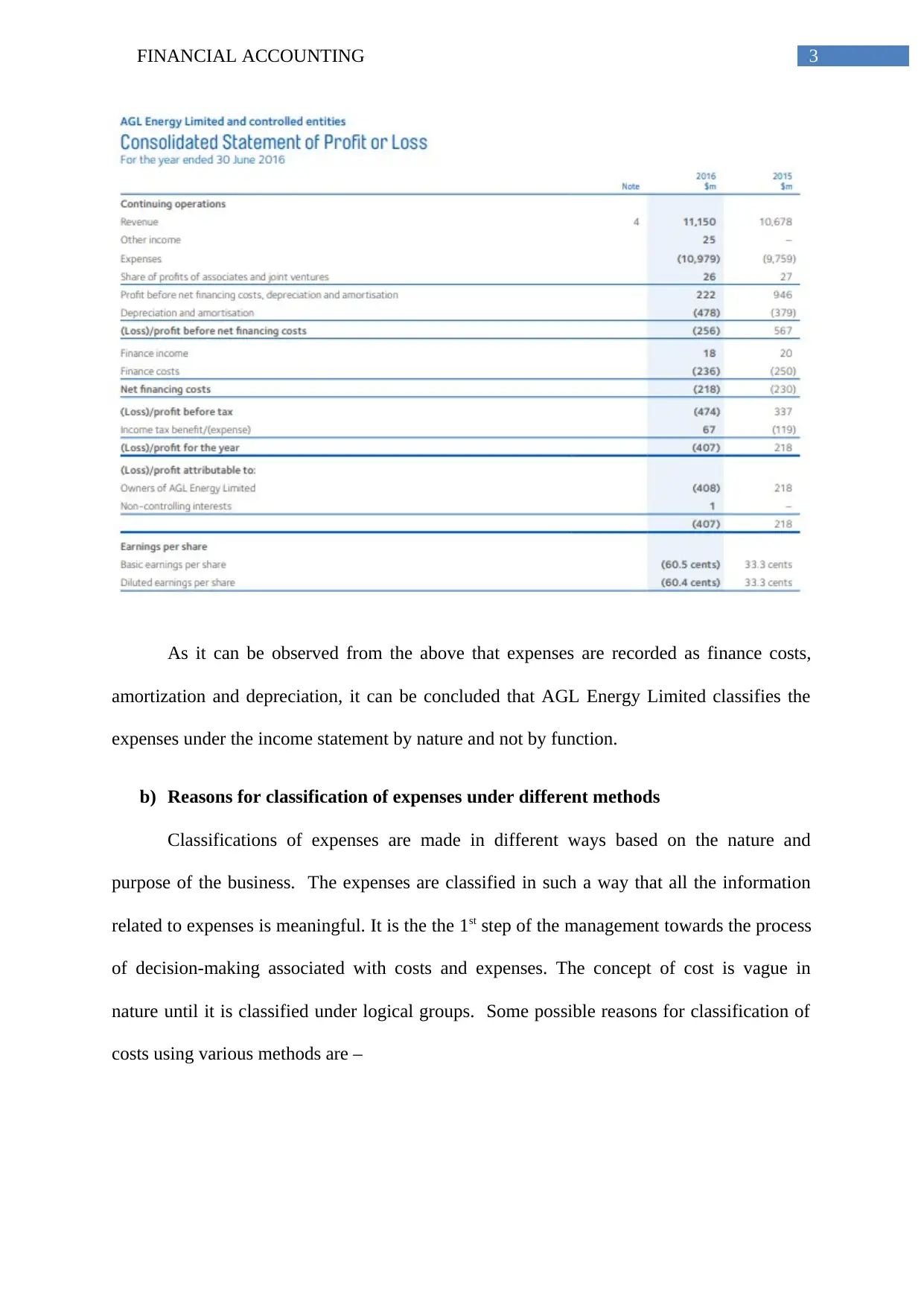
3FINANCIAL ACCOUNTING
As it can be observed from the above that expenses are recorded as finance costs,
amortization and depreciation, it can be concluded that AGL Energy Limited classifies the
expenses under the income statement by nature and not by function.
b) Reasons for classification of expenses under different methods
Classifications of expenses are made in different ways based on the nature and
purpose of the business. The expenses are classified in such a way that all the information
related to expenses is meaningful. It is the the 1st step of the management towards the process
of decision-making associated with costs and expenses. The concept of cost is vague in
nature until it is classified under logical groups. Some possible reasons for classification of
costs using various methods are –
As it can be observed from the above that expenses are recorded as finance costs,
amortization and depreciation, it can be concluded that AGL Energy Limited classifies the
expenses under the income statement by nature and not by function.
b) Reasons for classification of expenses under different methods
Classifications of expenses are made in different ways based on the nature and
purpose of the business. The expenses are classified in such a way that all the information
related to expenses is meaningful. It is the the 1st step of the management towards the process
of decision-making associated with costs and expenses. The concept of cost is vague in
nature until it is classified under logical groups. Some possible reasons for classification of
costs using various methods are –
Paraphrase This Document
Need a fresh take? Get an instant paraphrase of this document with our AI Paraphraser
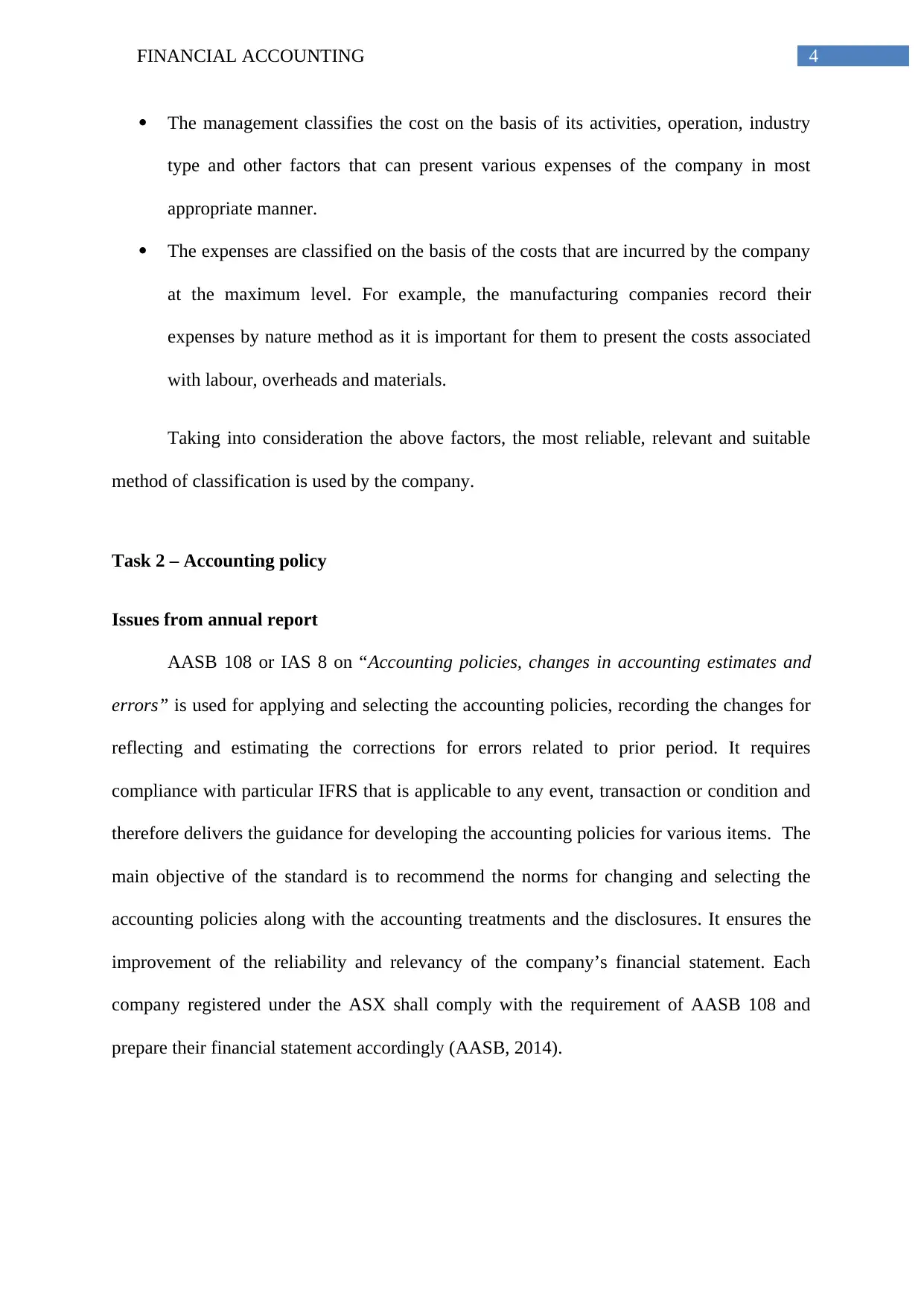
4FINANCIAL ACCOUNTING
The management classifies the cost on the basis of its activities, operation, industry
type and other factors that can present various expenses of the company in most
appropriate manner.
The expenses are classified on the basis of the costs that are incurred by the company
at the maximum level. For example, the manufacturing companies record their
expenses by nature method as it is important for them to present the costs associated
with labour, overheads and materials.
Taking into consideration the above factors, the most reliable, relevant and suitable
method of classification is used by the company.
Task 2 – Accounting policy
Issues from annual report
AASB 108 or IAS 8 on “Accounting policies, changes in accounting estimates and
errors” is used for applying and selecting the accounting policies, recording the changes for
reflecting and estimating the corrections for errors related to prior period. It requires
compliance with particular IFRS that is applicable to any event, transaction or condition and
therefore delivers the guidance for developing the accounting policies for various items. The
main objective of the standard is to recommend the norms for changing and selecting the
accounting policies along with the accounting treatments and the disclosures. It ensures the
improvement of the reliability and relevancy of the company’s financial statement. Each
company registered under the ASX shall comply with the requirement of AASB 108 and
prepare their financial statement accordingly (AASB, 2014).
The management classifies the cost on the basis of its activities, operation, industry
type and other factors that can present various expenses of the company in most
appropriate manner.
The expenses are classified on the basis of the costs that are incurred by the company
at the maximum level. For example, the manufacturing companies record their
expenses by nature method as it is important for them to present the costs associated
with labour, overheads and materials.
Taking into consideration the above factors, the most reliable, relevant and suitable
method of classification is used by the company.
Task 2 – Accounting policy
Issues from annual report
AASB 108 or IAS 8 on “Accounting policies, changes in accounting estimates and
errors” is used for applying and selecting the accounting policies, recording the changes for
reflecting and estimating the corrections for errors related to prior period. It requires
compliance with particular IFRS that is applicable to any event, transaction or condition and
therefore delivers the guidance for developing the accounting policies for various items. The
main objective of the standard is to recommend the norms for changing and selecting the
accounting policies along with the accounting treatments and the disclosures. It ensures the
improvement of the reliability and relevancy of the company’s financial statement. Each
company registered under the ASX shall comply with the requirement of AASB 108 and
prepare their financial statement accordingly (AASB, 2014).
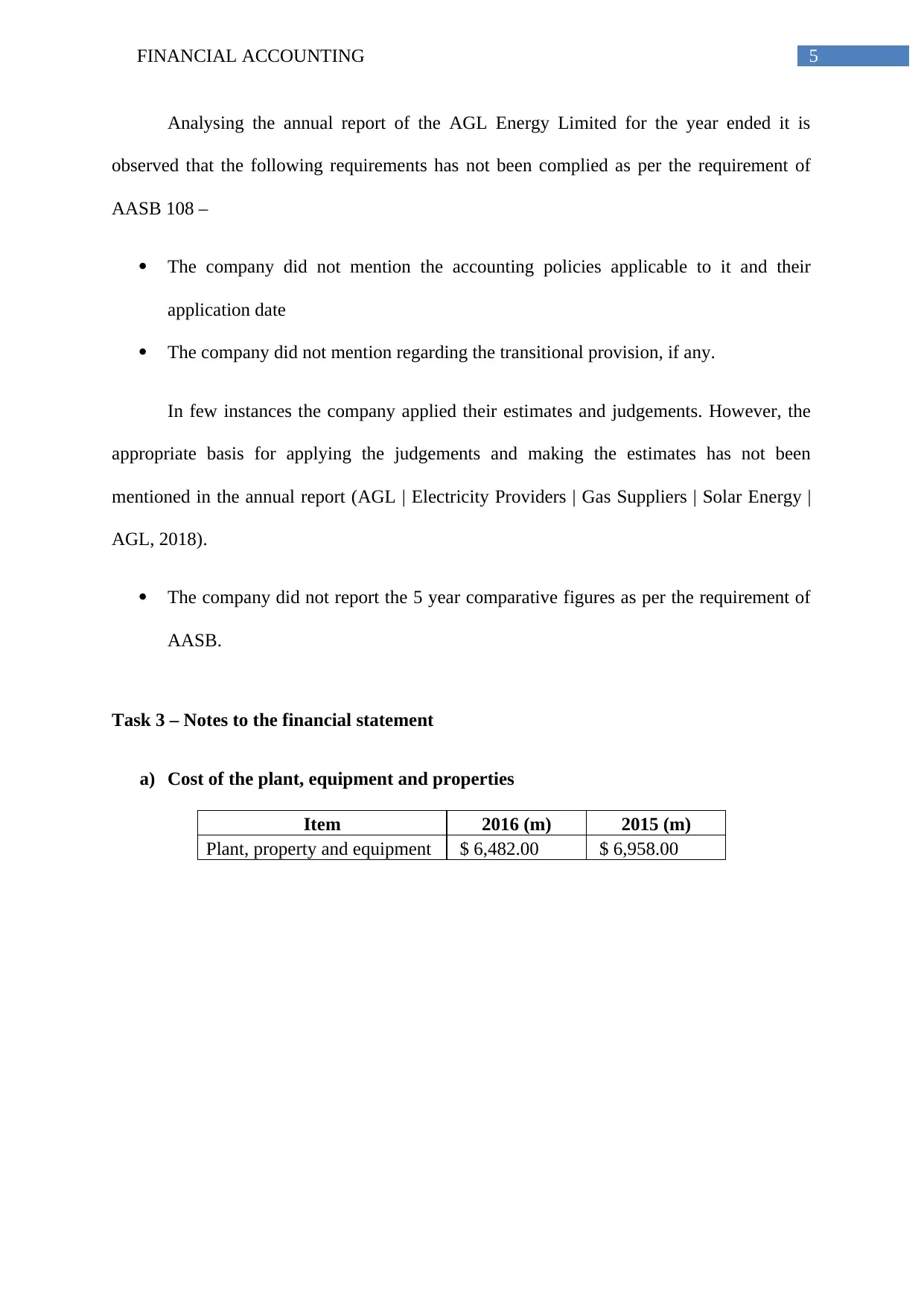
5FINANCIAL ACCOUNTING
Analysing the annual report of the AGL Energy Limited for the year ended it is
observed that the following requirements has not been complied as per the requirement of
AASB 108 –
The company did not mention the accounting policies applicable to it and their
application date
The company did not mention regarding the transitional provision, if any.
In few instances the company applied their estimates and judgements. However, the
appropriate basis for applying the judgements and making the estimates has not been
mentioned in the annual report (AGL | Electricity Providers | Gas Suppliers | Solar Energy |
AGL, 2018).
The company did not report the 5 year comparative figures as per the requirement of
AASB.
Task 3 – Notes to the financial statement
a) Cost of the plant, equipment and properties
Item 2016 (m) 2015 (m)
Plant, property and equipment $ 6,482.00 $ 6,958.00
Analysing the annual report of the AGL Energy Limited for the year ended it is
observed that the following requirements has not been complied as per the requirement of
AASB 108 –
The company did not mention the accounting policies applicable to it and their
application date
The company did not mention regarding the transitional provision, if any.
In few instances the company applied their estimates and judgements. However, the
appropriate basis for applying the judgements and making the estimates has not been
mentioned in the annual report (AGL | Electricity Providers | Gas Suppliers | Solar Energy |
AGL, 2018).
The company did not report the 5 year comparative figures as per the requirement of
AASB.
Task 3 – Notes to the financial statement
a) Cost of the plant, equipment and properties
Item 2016 (m) 2015 (m)
Plant, property and equipment $ 6,482.00 $ 6,958.00
⊘ This is a preview!⊘
Do you want full access?
Subscribe today to unlock all pages.

Trusted by 1+ million students worldwide
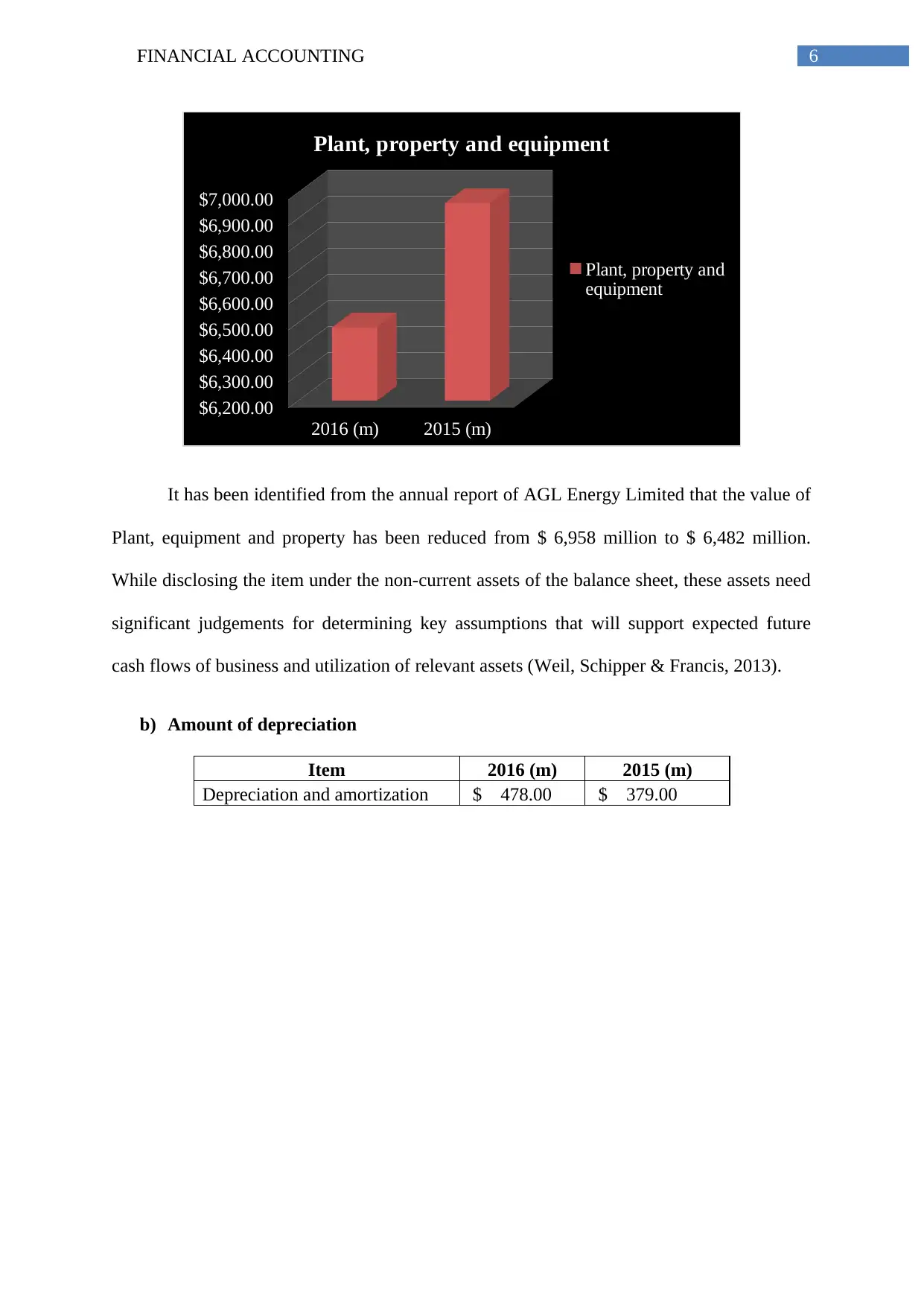
6FINANCIAL ACCOUNTING
2016 (m) 2015 (m)
$6,200.00
$6,300.00
$6,400.00
$6,500.00
$6,600.00
$6,700.00
$6,800.00
$6,900.00
$7,000.00
Plant, property and equipment
Plant, property and
equipment
It has been identified from the annual report of AGL Energy Limited that the value of
Plant, equipment and property has been reduced from $ 6,958 million to $ 6,482 million.
While disclosing the item under the non-current assets of the balance sheet, these assets need
significant judgements for determining key assumptions that will support expected future
cash flows of business and utilization of relevant assets (Weil, Schipper & Francis, 2013).
b) Amount of depreciation
Item 2016 (m) 2015 (m)
Depreciation and amortization $ 478.00 $ 379.00
2016 (m) 2015 (m)
$6,200.00
$6,300.00
$6,400.00
$6,500.00
$6,600.00
$6,700.00
$6,800.00
$6,900.00
$7,000.00
Plant, property and equipment
Plant, property and
equipment
It has been identified from the annual report of AGL Energy Limited that the value of
Plant, equipment and property has been reduced from $ 6,958 million to $ 6,482 million.
While disclosing the item under the non-current assets of the balance sheet, these assets need
significant judgements for determining key assumptions that will support expected future
cash flows of business and utilization of relevant assets (Weil, Schipper & Francis, 2013).
b) Amount of depreciation
Item 2016 (m) 2015 (m)
Depreciation and amortization $ 478.00 $ 379.00
Paraphrase This Document
Need a fresh take? Get an instant paraphrase of this document with our AI Paraphraser
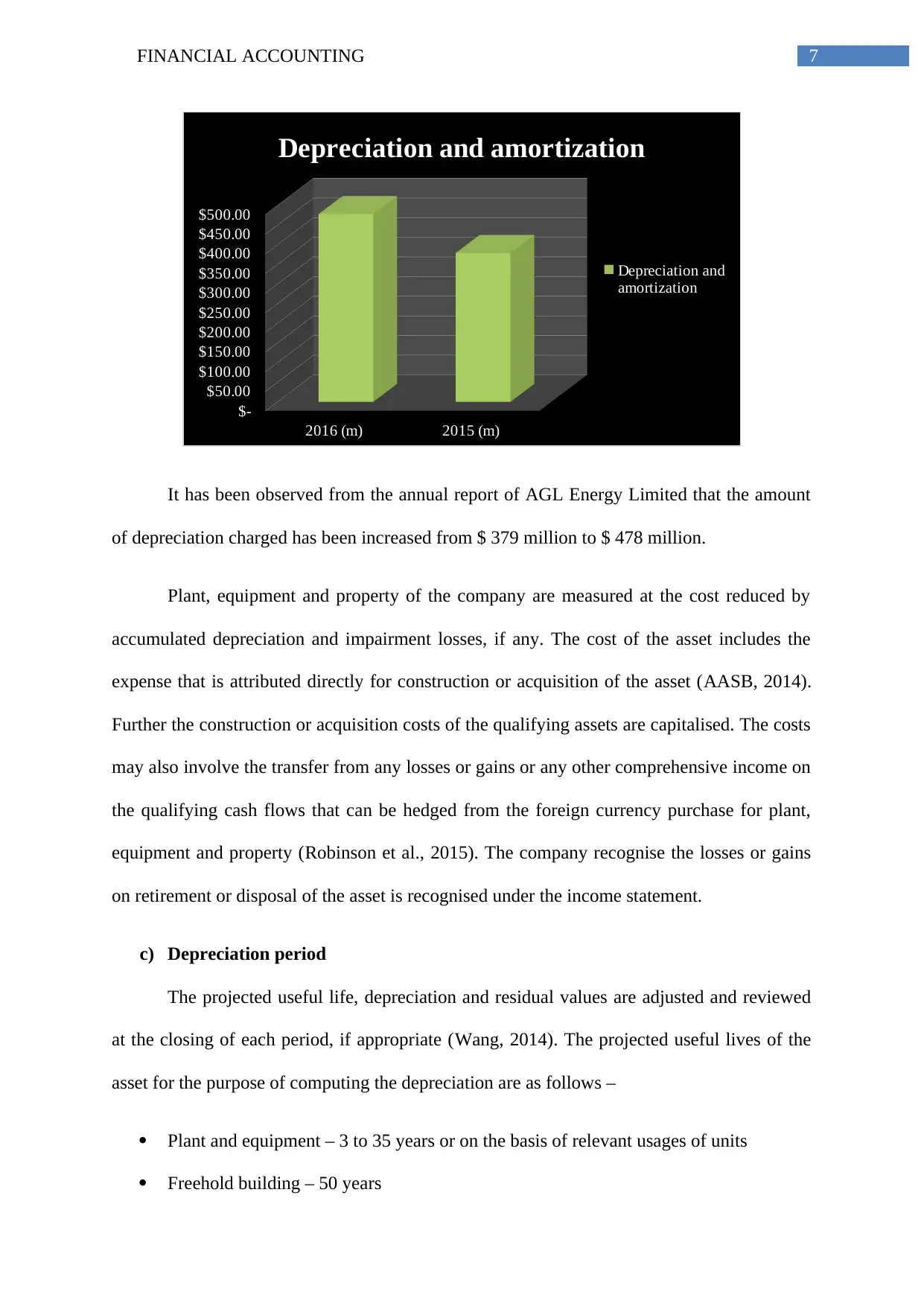
7FINANCIAL ACCOUNTING
2016 (m) 2015 (m)
$-
$50.00
$100.00
$150.00
$200.00
$250.00
$300.00
$350.00
$400.00
$450.00
$500.00
Depreciation and amortization
Depreciation and
amortization
It has been observed from the annual report of AGL Energy Limited that the amount
of depreciation charged has been increased from $ 379 million to $ 478 million.
Plant, equipment and property of the company are measured at the cost reduced by
accumulated depreciation and impairment losses, if any. The cost of the asset includes the
expense that is attributed directly for construction or acquisition of the asset (AASB, 2014).
Further the construction or acquisition costs of the qualifying assets are capitalised. The costs
may also involve the transfer from any losses or gains or any other comprehensive income on
the qualifying cash flows that can be hedged from the foreign currency purchase for plant,
equipment and property (Robinson et al., 2015). The company recognise the losses or gains
on retirement or disposal of the asset is recognised under the income statement.
c) Depreciation period
The projected useful life, depreciation and residual values are adjusted and reviewed
at the closing of each period, if appropriate (Wang, 2014). The projected useful lives of the
asset for the purpose of computing the depreciation are as follows –
Plant and equipment – 3 to 35 years or on the basis of relevant usages of units
Freehold building – 50 years
2016 (m) 2015 (m)
$-
$50.00
$100.00
$150.00
$200.00
$250.00
$300.00
$350.00
$400.00
$450.00
$500.00
Depreciation and amortization
Depreciation and
amortization
It has been observed from the annual report of AGL Energy Limited that the amount
of depreciation charged has been increased from $ 379 million to $ 478 million.
Plant, equipment and property of the company are measured at the cost reduced by
accumulated depreciation and impairment losses, if any. The cost of the asset includes the
expense that is attributed directly for construction or acquisition of the asset (AASB, 2014).
Further the construction or acquisition costs of the qualifying assets are capitalised. The costs
may also involve the transfer from any losses or gains or any other comprehensive income on
the qualifying cash flows that can be hedged from the foreign currency purchase for plant,
equipment and property (Robinson et al., 2015). The company recognise the losses or gains
on retirement or disposal of the asset is recognised under the income statement.
c) Depreciation period
The projected useful life, depreciation and residual values are adjusted and reviewed
at the closing of each period, if appropriate (Wang, 2014). The projected useful lives of the
asset for the purpose of computing the depreciation are as follows –
Plant and equipment – 3 to 35 years or on the basis of relevant usages of units
Freehold building – 50 years
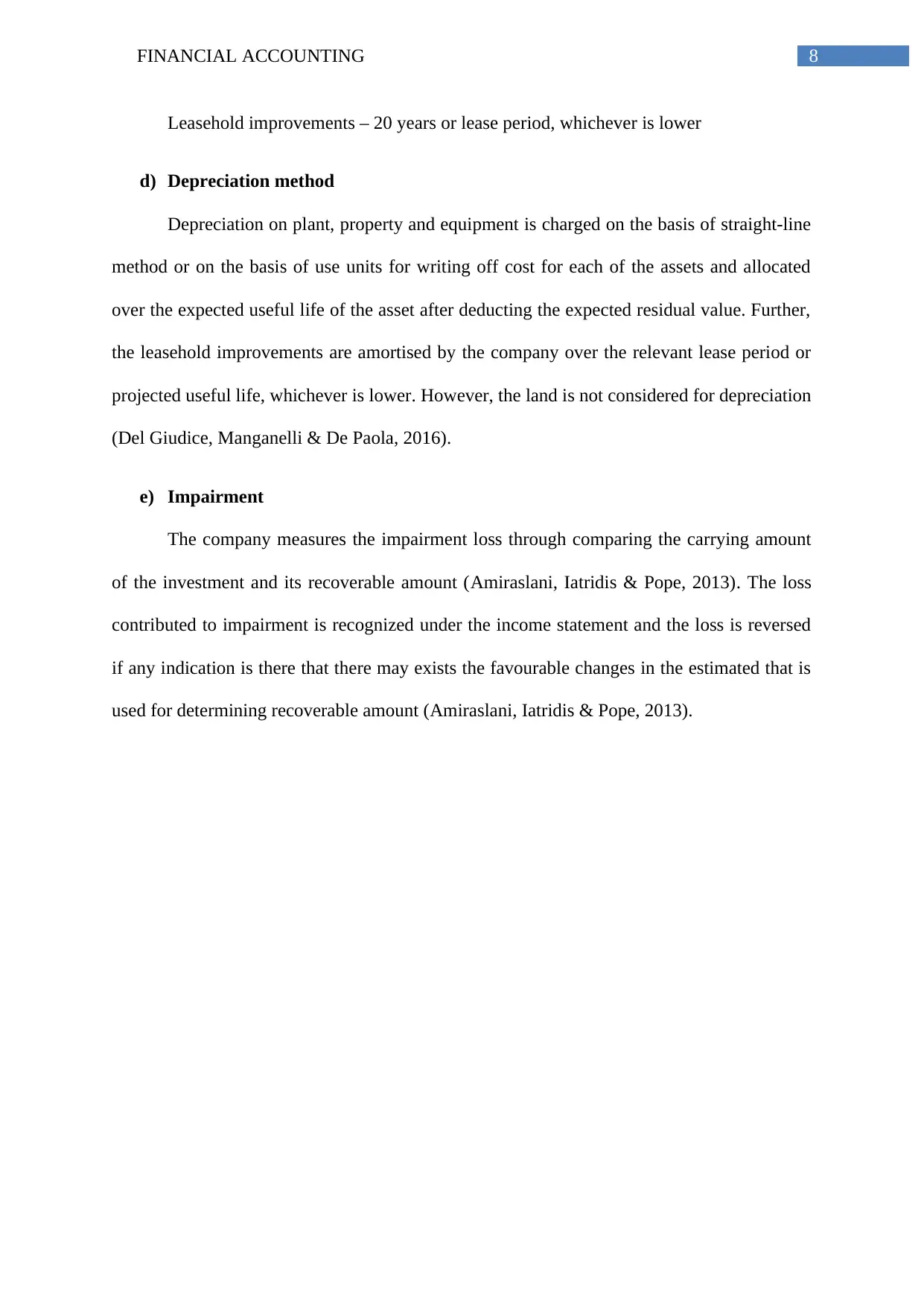
8FINANCIAL ACCOUNTING
Leasehold improvements – 20 years or lease period, whichever is lower
d) Depreciation method
Depreciation on plant, property and equipment is charged on the basis of straight-line
method or on the basis of use units for writing off cost for each of the assets and allocated
over the expected useful life of the asset after deducting the expected residual value. Further,
the leasehold improvements are amortised by the company over the relevant lease period or
projected useful life, whichever is lower. However, the land is not considered for depreciation
(Del Giudice, Manganelli & De Paola, 2016).
e) Impairment
The company measures the impairment loss through comparing the carrying amount
of the investment and its recoverable amount (Amiraslani, Iatridis & Pope, 2013). The loss
contributed to impairment is recognized under the income statement and the loss is reversed
if any indication is there that there may exists the favourable changes in the estimated that is
used for determining recoverable amount (Amiraslani, Iatridis & Pope, 2013).
Leasehold improvements – 20 years or lease period, whichever is lower
d) Depreciation method
Depreciation on plant, property and equipment is charged on the basis of straight-line
method or on the basis of use units for writing off cost for each of the assets and allocated
over the expected useful life of the asset after deducting the expected residual value. Further,
the leasehold improvements are amortised by the company over the relevant lease period or
projected useful life, whichever is lower. However, the land is not considered for depreciation
(Del Giudice, Manganelli & De Paola, 2016).
e) Impairment
The company measures the impairment loss through comparing the carrying amount
of the investment and its recoverable amount (Amiraslani, Iatridis & Pope, 2013). The loss
contributed to impairment is recognized under the income statement and the loss is reversed
if any indication is there that there may exists the favourable changes in the estimated that is
used for determining recoverable amount (Amiraslani, Iatridis & Pope, 2013).
⊘ This is a preview!⊘
Do you want full access?
Subscribe today to unlock all pages.

Trusted by 1+ million students worldwide
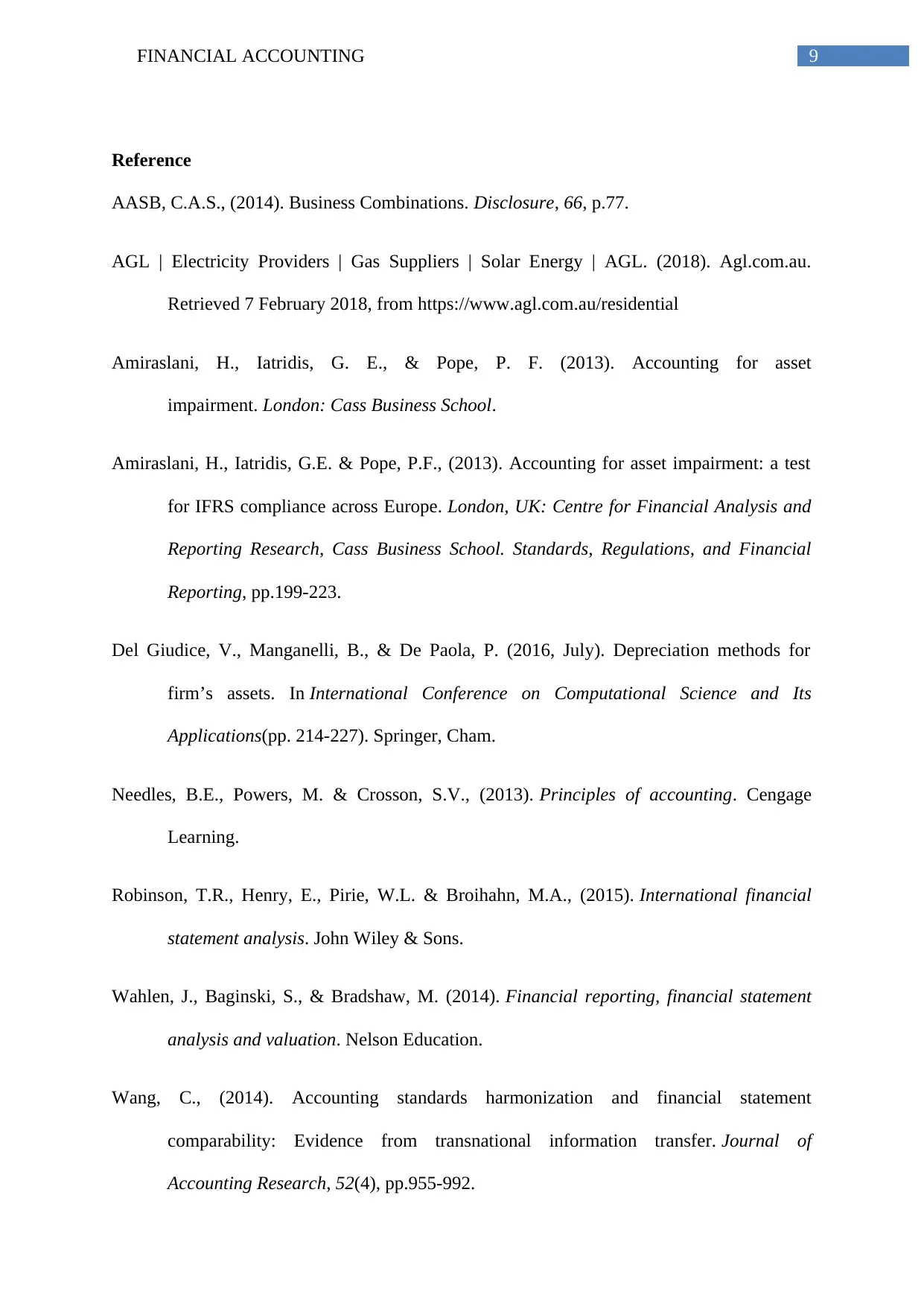
9FINANCIAL ACCOUNTING
Reference
AASB, C.A.S., (2014). Business Combinations. Disclosure, 66, p.77.
AGL | Electricity Providers | Gas Suppliers | Solar Energy | AGL. (2018). Agl.com.au.
Retrieved 7 February 2018, from https://www.agl.com.au/residential
Amiraslani, H., Iatridis, G. E., & Pope, P. F. (2013). Accounting for asset
impairment. London: Cass Business School.
Amiraslani, H., Iatridis, G.E. & Pope, P.F., (2013). Accounting for asset impairment: a test
for IFRS compliance across Europe. London, UK: Centre for Financial Analysis and
Reporting Research, Cass Business School. Standards, Regulations, and Financial
Reporting, pp.199-223.
Del Giudice, V., Manganelli, B., & De Paola, P. (2016, July). Depreciation methods for
firm’s assets. In International Conference on Computational Science and Its
Applications(pp. 214-227). Springer, Cham.
Needles, B.E., Powers, M. & Crosson, S.V., (2013). Principles of accounting. Cengage
Learning.
Robinson, T.R., Henry, E., Pirie, W.L. & Broihahn, M.A., (2015). International financial
statement analysis. John Wiley & Sons.
Wahlen, J., Baginski, S., & Bradshaw, M. (2014). Financial reporting, financial statement
analysis and valuation. Nelson Education.
Wang, C., (2014). Accounting standards harmonization and financial statement
comparability: Evidence from transnational information transfer. Journal of
Accounting Research, 52(4), pp.955-992.
Reference
AASB, C.A.S., (2014). Business Combinations. Disclosure, 66, p.77.
AGL | Electricity Providers | Gas Suppliers | Solar Energy | AGL. (2018). Agl.com.au.
Retrieved 7 February 2018, from https://www.agl.com.au/residential
Amiraslani, H., Iatridis, G. E., & Pope, P. F. (2013). Accounting for asset
impairment. London: Cass Business School.
Amiraslani, H., Iatridis, G.E. & Pope, P.F., (2013). Accounting for asset impairment: a test
for IFRS compliance across Europe. London, UK: Centre for Financial Analysis and
Reporting Research, Cass Business School. Standards, Regulations, and Financial
Reporting, pp.199-223.
Del Giudice, V., Manganelli, B., & De Paola, P. (2016, July). Depreciation methods for
firm’s assets. In International Conference on Computational Science and Its
Applications(pp. 214-227). Springer, Cham.
Needles, B.E., Powers, M. & Crosson, S.V., (2013). Principles of accounting. Cengage
Learning.
Robinson, T.R., Henry, E., Pirie, W.L. & Broihahn, M.A., (2015). International financial
statement analysis. John Wiley & Sons.
Wahlen, J., Baginski, S., & Bradshaw, M. (2014). Financial reporting, financial statement
analysis and valuation. Nelson Education.
Wang, C., (2014). Accounting standards harmonization and financial statement
comparability: Evidence from transnational information transfer. Journal of
Accounting Research, 52(4), pp.955-992.
Paraphrase This Document
Need a fresh take? Get an instant paraphrase of this document with our AI Paraphraser
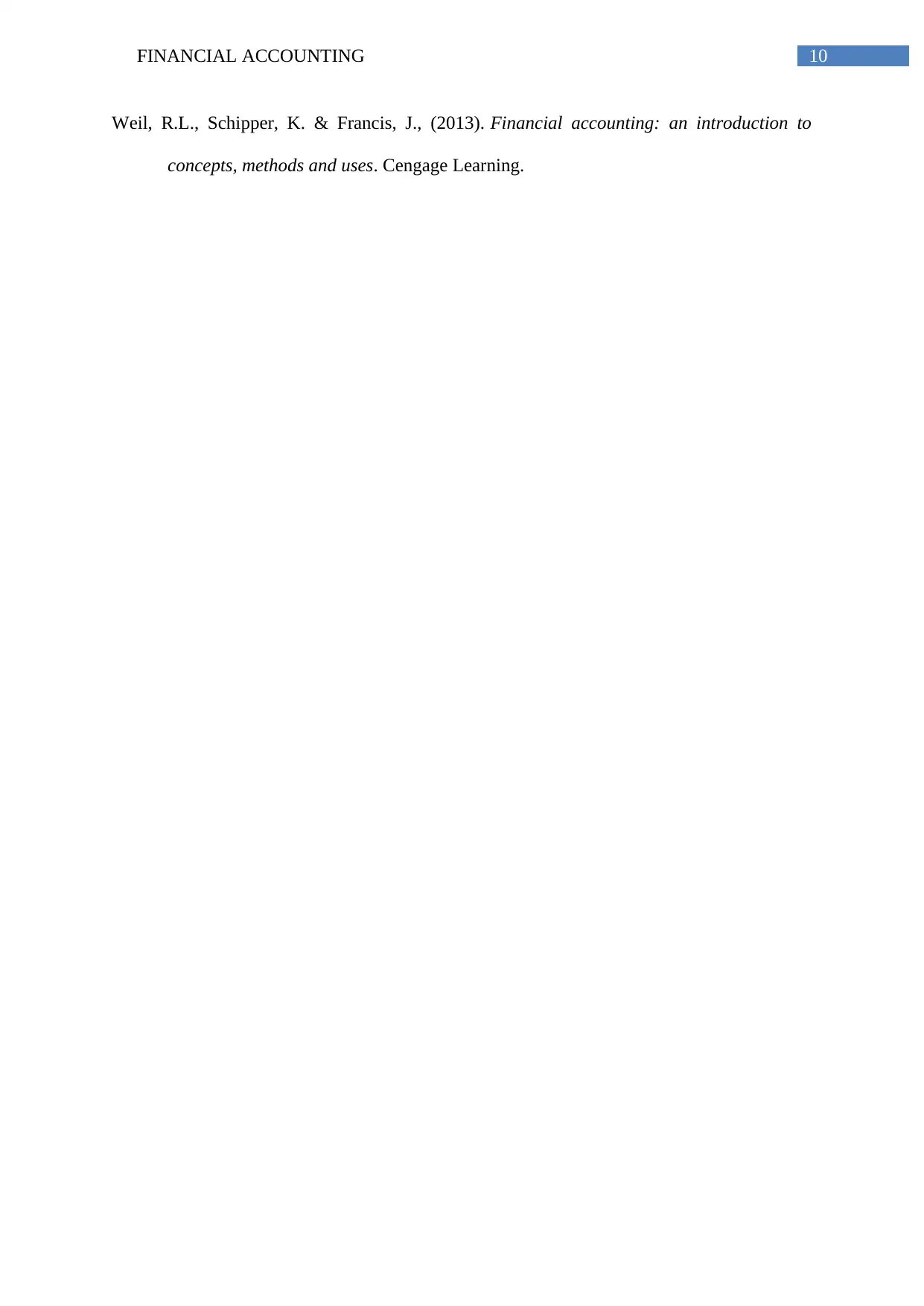
10FINANCIAL ACCOUNTING
Weil, R.L., Schipper, K. & Francis, J., (2013). Financial accounting: an introduction to
concepts, methods and uses. Cengage Learning.
Weil, R.L., Schipper, K. & Francis, J., (2013). Financial accounting: an introduction to
concepts, methods and uses. Cengage Learning.
1 out of 11
Related Documents
Your All-in-One AI-Powered Toolkit for Academic Success.
+13062052269
info@desklib.com
Available 24*7 on WhatsApp / Email
![[object Object]](/_next/static/media/star-bottom.7253800d.svg)
Unlock your academic potential
Copyright © 2020–2025 A2Z Services. All Rights Reserved. Developed and managed by ZUCOL.





